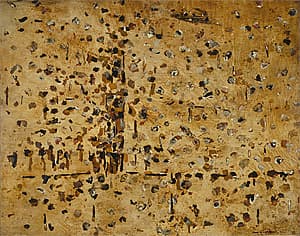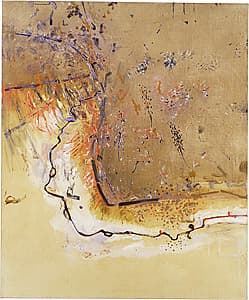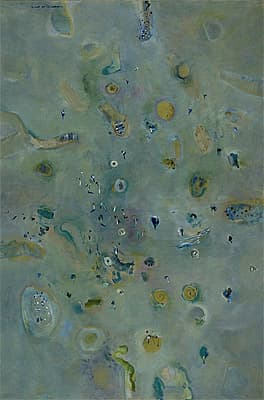About
 All of the works in the exhibition are now available for viewing within Google Earth. Explore all the works in the exhibition and the geographic locations they came from.
All of the works in the exhibition are now available for viewing within Google Earth. Explore all the works in the exhibition and the geographic locations they came from.
LAUNCH GOOGLE EARTH VIEW
Google Earth browser plugin required download here
Fred Williams revolutionised the way we see and think about the Australian landscape. In the 1960s, inspired by the landscape of Victoria close to where he lived, he distilled the essence of environment in his paintings and works on paper. However, while the subjects were regional, Williams wanted to convey a wider sense of place. The local was the template for the more general, unifying elements of the continent.
His intuitive sense of unity was confirmed over the years with his growing interest in geology and his broadening experience of diverse aspects of the country, from Erith Island and Flinders Island in Bass Strait in the south to Cape York in far north Queensland to the Pilbara region in Western Australia. For all the differences he perceived in these places, he also grasped underlying commonalities.
As a student in the 1940s, Williams had been interested in a tonalist approach to colour that came from his art training at the National Gallery School in Melbourne. When he returned home to Australia in 1957, after five years living in London, he was immensely taken with the subtle yet richly varied tones of the Australian bush. At the time, John Brack asked him where he was going to focus his energies in his art, and Williams responded that he was going to paint the gum tree. Like many others, Brack thought this might be a retrograde move, but Williams was determined.
 'The Nattai River' 1958 oil on composition board 88.5 x 92.1 cm National Gallery of Victoria, Melbourne purchased 1958 © estate of Fred Williams
'The Nattai River' 1958 oil on composition board 88.5 x 92.1 cm National Gallery of Victoria, Melbourne purchased 1958 © estate of Fred WilliamsHe was soon painting the bush close to Mittagong in the Southern Highlands where he stayed with friends. In works such as The Nattai River 1958 (his first painting to enter a public collection), he conveyed his feeling for the subtleties of the bush. He was also mindful of the ways in which the basic forms of trees, rocks and the rivers could become structural elements in his compositions. His approach was inspired by an ever-deepening knowledge of art of the past. Among his favourite artists were Australian Impressionists such as Tom Roberts and Arthur Streeton and French Post-Impressionists such as Paul Cézanne and Georges Braque.

'You Yangs landscape' 1963 oil on composition board 119.5 x 152 cm Art Gallery of New South Wales, Sydney purchased 1980 © estate of Fred Williams
In the 1960s, Williams often painted outdoors with gouache, subsequently working on his oil paintings back in the studio. The breakthrough came with the You Yangs series inspired by an area of granite ridges and plains of low vegetation scattered across open areas. Compared with the English landscape that was tamed and ordered, Williams recognised that a paradoxically defining aspect of the Australian landscape was the random scatter of elements with no focal point. He was able to conceptualise this landscape from an aerial perspective, the rocks and small trees translated into sensuous touches of paint. In some paintings, such as You Yangs landscape 1963, these notations were painted over golden grounds, which he described as ‘painter’s honey’; in others, he adopted delicate, pale sandy hues, affirming his mostly tonal approach to colour in the first two decades of his artistic development.
Although he was an innately modest man who did not enjoy talking about his work, Williams was ambitious for his art. He saw his work as part of a tradition of Australian landscape painting and was also open to contemporary developments. In the late 1960s, he was interested in Minimalism and Colour Field paintings, which he saw in the exhibition Two decades of American painting that came to Australia in 1967. Part of his brilliance as an artist was the way that he selectively adapted aspects of his sources into works that clearly and distinctively revealed his own vision. For instance, he recognised that tiny, minimal notations with the brush on the space of the paper or canvas could correspond with a sense of the spaciousness of the Australian landscape.
In the 1970s, Williams felt an urgent desire to paint with colour, partly informed by the vibrant Colour Field paintings he had seen and by his need to reinvent his art after going as far as he could with his minimalist Australian landscape series painted indoors. He began painting outdoors in oil on canvas, often in the company of friends. He liked to get to know particular landscapes well, returning again and again and amassing large series of works over several years. The outdoor oils were generally complemented by what he called ‘a summation oil’ painted in the studio. While the outdoor paintings were generally more spontaneous and representational, the studio works, such as Yan Yean 1972–73, were more distilled and abstracted, rather like his earlier approach. Only now they were suffused with brilliant colour.
 'Dry creek bed, Werribee Gorge' I 1977 oil on canvas 182.3 x 152.2 cm Tate, London presented by the artist's estate, 2006 © estate of Fred Williams
'Dry creek bed, Werribee Gorge' I 1977 oil on canvas 182.3 x 152.2 cm Tate, London presented by the artist's estate, 2006 © estate of Fred WilliamsWilliams’s special talent was abstracting from the real or, as he put it, seeing the world ‘in terms of paint’. The paintings that convey the most seamless transition between his minimal works of the late 1960s and the fullness of sumptuous colour of the 1970s and between close observation of the real and abstraction were his paintings of water. These include his evocative seascapes of the Victorian coastline and his vibrant oil paintings of Erith Island in Bass Strait, such as Beachscape, Erith Island I 1974. Painted in horizontal strips, these works both recall early colonial topographical drawings and watercolours and find affinities with contemporary abstraction.
Works like this were shown in the retrospective of gouaches Fred Williams: landscapes of a continent at the Museum of Modern Art in New York in 1977. He was the first Australian artist to be invited to have a solo exhibition at the Museum of Modern Art—the heartland of Modernism with a collection that included many of the great Post-Impressionist artists Williams had admired over the years, including Cézanne and Henri Matisse. Matisse’s large cut-out installation The swimming pool 1952 was on display at the same time as Williams’s exhibition, and a museum brochure linked their passion for colour. Williams was naturally overjoyed at the opportunity of the exhibition. The experience of being in New York (it was his first visit to the city) also confirmed where he wanted to work: ‘I will never paint anywhere but in Australia because I know Australia … I must be inside looking out, not outside looking in’.
A few months after his return from New York, Williams’s diary reveals that he was in tropical far north Queensland—in Weipa on Cape York Peninsula. Remarkably, this was the first time he had had the opportunity to fly in a light aircraft low over the landscape. It was something he had always dreamed of, and he was not disappointed. His gouaches Weipa shoreline and Bushfire, Weipa II, both painted in 1977, are among his most inventive compositions.
A number of his oils of the late 1970s also reveal that he was continually reinventing his approaches to landscape in this medium. This is apparent in his paintings of dry and the wet landscapes such as Snow storm, Kosciusko 1976–77, with its white and cool hues, and Dry creek bed, Werribee Gorge I 1977, which shimmers with luminous warmth. In the latter, the line of the dry creek appears etched into the landscape while the bright touches of colour convey the vitality of plant life.
The vibrancy of Williams’s palette developed further in works inspired by the Pilbara region of West Australia. After visiting the region twice in 1979 and completing around 100 works on paper, he painted the related oils in 1981. Among his less well-known, rather subtle late oils relating to his experience in the Kimberleys is Claypans I 1981. Painted the year before Williams’s death at the age of 55, it suggests continuities with the past as well as new directions. The work evokes the origins of life in an aqueous environment, recalling his comment many years earlier that a muddy pool in the You Yangs gave him the feeling of the beginning of Creation.
Although Williams was not keen on discussing his works, reading between the lines, he made many salient comments about art over the years. He was always keen on the idea of artists’ retrospectives, enjoying the journeys they provide across a spectrum of work over time. This National Gallery of Australia’s retrospective Fred Williams: infinite horizons offers visitors just such a chance to travel with Williams on a journey from 1947 to 1981, to experience the work of an artist of great dedication who reinvented the way we consider the Australian landscape and who continued to refresh his vision through to his vital late works.

'Beachscape, Erith Island I' 1974 gouache and sand on paper 55.6 x 77.6 cm National Gallery of Australia, Canberra purchased from Gallery admission charges, 1983 © estate of Fred Williams
Deborah Hart exhibition curator and Senior Curator, Australian Painting and Sculpture post-1920I



